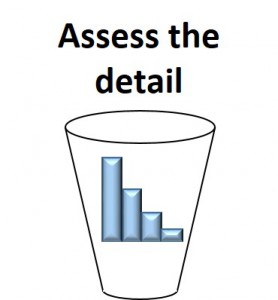Situation
David leads a team of 13 professional staff and has noticed growing tension between two of his key staff. This tension has escalated recently and threatens to undermine the morale and performance of the entire team. David has decided that he needs to intervene but wants to ensure that he does not make things worse. As he usually does in such complex people-based situations, he decides to run the intervention through as a ‘thought experiment’ before taking any action.
 David’s initial intention is to get both people together around a table and surface the issues that are creating the tension. In his thought experiment he plays the meeting out in his mind in sufficient detail to pick up any aspect that is likely to influence the conduct and outcome of the meeting. The thought experiment shows that the tone of the meeting will be influenced by the expectations and frame of mind of the participants when they enter the meeting. This highlights to David that the way he invites both people to the meeting will be important. He then thinks through the detail of how he will set up and frame the meeting and then reruns (iterates) his thought experiment.
David’s initial intention is to get both people together around a table and surface the issues that are creating the tension. In his thought experiment he plays the meeting out in his mind in sufficient detail to pick up any aspect that is likely to influence the conduct and outcome of the meeting. The thought experiment shows that the tone of the meeting will be influenced by the expectations and frame of mind of the participants when they enter the meeting. This highlights to David that the way he invites both people to the meeting will be important. He then thinks through the detail of how he will set up and frame the meeting and then reruns (iterates) his thought experiment.
As David reruns the thought experiment, he reaches a point where he does not have a clear enough understanding of the context for the tension between the staff to be reasonably confident about how the meeting will progress. Because this is just a thought experiment, David could decide to make an assumption about the context and continue the experiment. If he does, it is important for him to be aware that the rest of the thought experiment is based on an assumption, not a fact. David tests several assumptions at this point to experimentally see how they affect the conduct and outcome of the meeting. Once he does this, David finds that, with his current level of context knowledge, it is too risky to hold the meeting at this time. He decides that he needs to do some real information gathering before holding a joint meeting with both of the staff. David’s previous thought experiment about the conduct of the meeting will be valuable in directing the nature and focus of the information gathering. Once the information is gathered, the thought experiment can be rerun again.
This example highlights the critical aspects of successful thought experiments: clear understanding of the objective in the situation; ability to be immersed in the context in sufficient detail to recognise critical issues and decision points; awareness of any assumptions and a preparedness to test them, and a preparedness to iterate the thought experiment and modify the approach (design) based on any learning.





Follow Us!